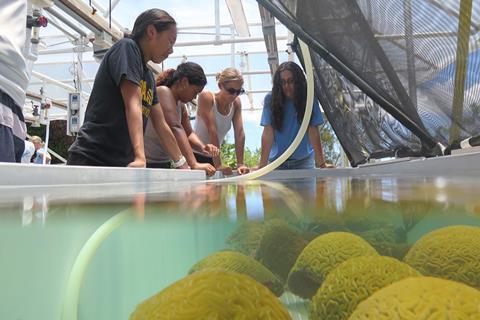A new study by the Bermuda Institute of Ocean Sciences (ASU BIOS), a unit of the Julie Ann Wrigley Global Futures Laboratory at Arizona State University, has challenged a long-standing oversight in coral reef science, revealing that respiration in corals and algae varies significantly throughout the day, rather than remaining constant. Published in PLoS One, the study reveals that respiration rates in reef organisms are highly dynamic, peaking in the afternoon several hours after the height of photosynthesis.

The research was led by marine benthic ecologist, Yvonne Sawall, who is an assistant scientist at ASU BIOS and assistant professor at the School of Ocean Futures at ASU, and co-authored by Roderick Bakker, former research technician, Natalia Padillo-Anthemides and Nicole Adamson, both former Research Experiences for Undergraduates students at ASU BIOS.
READ MORE: Coral fusion teams with microbiology to advance coral reef restoration
READ MORE: Coral reefs exude myriad chemicals, fueling dynamic microbial recycling of nutrients
Traditionally, scientists have relied on nighttime respiration rates to calculate daily energy budgets for reef organisms. However, this research shows that this approach underestimates daily respiration and gross photosynthesis by up to 23% and 18%, respectively.
“This is the first study that systematically investigated respiration under natural, diurnal light conditions,” said Sawall. “We found that both corals and algae show increased respiration during the day, especially in the afternoon. This has a big impact on how we calculate energy use and production, which are key indicators of reef health.”
Outdoor mesocosm
Using specimens collected from Bermuda’s coral reefs, the research team conducted detailed seasonal measurements in ASU BIOS’s outdoor mesocosm facility, simulating near-natural light and temperature conditions. They tracked oxygen changes throughout the day to assess the patterns of respiration and photosynthesis in three coral and three algae species.
The study was motivated by a gap in the traditional calculation of reef energy budgets. “Scientists have known that respiration depends on light, but many discounted its variability, assuming it wouldn’t significantly affect the math,” said Sawall. “Our results show otherwise.”
Accurate estimates of energy use and production are vital for understanding how reef organisms cope with environmental stressors, including rising temperatures, ocean acidification, and pollution. Energy availability affects an organism’s ability to fuel protective processes, such as repairing cell damage or combating oxidative stress.
Energy budgets
“This research will help refine energy budgets and essentially determine how much energy corals and algae gain through photosynthesis and use through respiration,” Sawall explained. “That matters because resilience to climate change is directly linked to energy availability and how that energy is allocated.”
Bermuda proved to be an ideal research site due to its strong seasonal shifts in light and temperature, which allowed the team to examine how respiration patterns change across seasons. These findings can improve predictions of reef responses to environmental change and aid researchers in developing more accurate models for coral health and productivity.







No comments yet